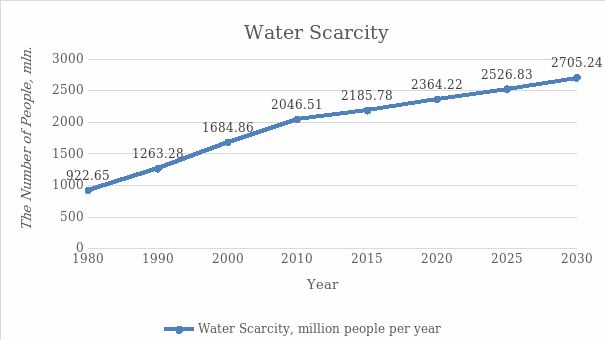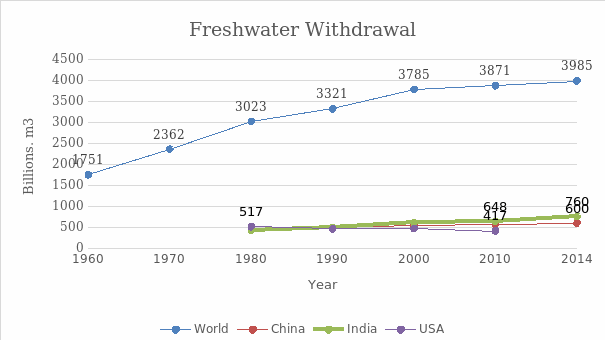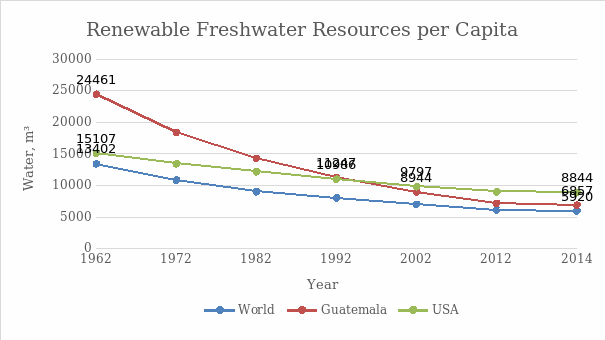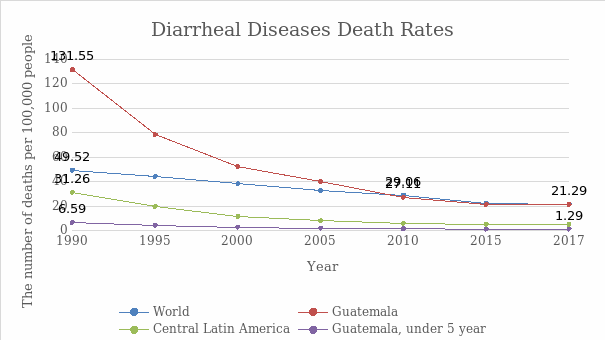Introduction
Water is a vital resource that not only enables life on Earth but also promotes the world’s economic development and the wellbeing of populations. It is extensively used in almost all fields of human activity, especially domestic household, agriculture, and for municipal needs. Nevertheless, in the context of rapid climate change, accessibility to clean water has grown into one of the most alarming and complicated issues, which severely disturbs the global scientific community, politicians, and billions of ordinary people. Climate change is the root cause of the expansion of droughts and the increasing frequency of floods and prolonged downpours. By affecting the water cycle, this phenomenon makes radical shifts in the global distribution of precipitation falls.
Moreover, climate change worsens sanitation and considerably contributes to the spread of numerous infection diseases, such as rotavirus, malaria, cholera, dysentery, typhoid fever, Escherichia Coli, and others. Floods because of increased precipitation also pollute large bodies of water by bringing various contaminants, including fertilizers and industrial or domestic waste. Overall, against the background of the increasing water consumption and withdrawal, safe water sources are gradually exhausting, resulting in acute water scarcity around the world.
Concerning water resources, climate change also creates significant problems on local levels, especially in the Caribbean, Latin America, Middle East, and North and Central Africa. For instance, in Latin America, droughts, floods, poor sewage waste treatment, hurricanes, and oil spills inflict dire economic and social damage, ruining infrastructure and causing thousands of deaths every year. Thus, this paper aims at conducting in-depth research and analysis on climate change’s effect on water accessibility, providing the recent data. The paper also considers the impact of increasing water pathogens on residents’ lives in Guatemala.
Figures and Graphs




Analysis
- Figure 1. concerns the problem of water scarcity many people encounter throughout the world for the last four decades. In particular, it shows that as of 1980, over 920 million people experienced a deficit of water for their domestic, civil, and other needs. At the beginning of the new millennium, the rate reached almost 1,7 billion individuals and, in 2010, exceed the point of 2 billion. As of 2021, the indicator has achieved nearly 2,4 billion and is projected to rise to more than 2,7 billion in 2030. Altogether, it can be concluded that water scarcity has grown 2,5 times compared to 1980, which indicates a severe problem needing urgent measures.
- Figure 2. mirrors the situation of global freshwater withdrawal, starting from 1960. Specifically, water use equaled 1751 billion m³ in 1960, while in 2014, the rate achieved almost 4000 billion m3, thereby demonstrating a rampant increase of over two times. However, since 2000, the graph is flattening, indicating the gradual deceleration of the growth. Besides, the figure displays the leading water users, namely, China, India, and the US. As can be observed, the first two countries show a stable increase in freshwater withdrawal, while the United States has decreasing rate. In 2014, India became the most significant consumer of water, using above 760 billion cubic meters per year.
- Figure 3. relates to renewable freshwater resources per capita in the world, the USA, and Guatemala. As can be seen, renewable freshwater resources have steadily reduced since the 1960s. Specifically, in 1962, almost 13500 m³ of freshwater was per person on average, while this rate diminished to 5920 m³, that is, more than two times. It is also worth observing the rapid decline of Guatemala’s resources – nearly four times. The decrease was so impetuous that, since 2000, Guatemala began to have less renewable freshwater than the US.
- Figure 4. is directly related to the second question since water is the primary source of diarrheal diseases spreading, most of which can be fatal. In particular, it demonstrates and compares the rates of deaths per 100000 people in the world, Guatemala, and Central Latin America. According to the data, while in 1990, the global rate comprised 49,52, Guatemala had 131,55 deaths due to diarrheal diseases. The chart demonstrates that Guatemala’s rate rapidly decreased by 2017, reaching the world average and amounting to 21,29, that is, a reduction of over ten times. The children’s mortality from diarrheal diseases also curtailed nearly five times. However, it is worth noting that Guatemala’s rate is still higher than in Central Latin America, a region where Guatemala is located.
Discussion
As the figures show, water scarcity is gradually becoming a pressing and enormous concern for humanity. The increased deficit of water is primarily connected with the growing population of the world, rising industrial and agricultural needs, and global warming. Indeed, increasing global temperature provokes the expansion of deserts worldwide and amplified water evaporation from a particular area, especially in North Africa and the Middle East. Changing patterns in atmospheric water distribution also lead to enhanced precipitation in other regions. This results in considerable problems with sanitation since floods pollute rivers, lakes, canals, or ponds, making them undrinkable and salty. In its report, WaterAid states that with the present climate change scenario, 25 million – 700 million people are expected to leave their homes by 2030 (Oboko and Callister 3). Massive migration resulting from cumulative water shortage will cause severe military and social conflicts around the globe, which is highly likely to acquire unprecedented scale.
The point also is that many countries, especially those with expanding water withdrawal, such as China and India, treat their water resources ineffectively. Guatemala faces this problem as well against the background of increasing population and growing economy. Furthermore, these states tend to contaminate their rivers, lakes, and land with poisoning industrials substances and an immense amount of trash. On the contrary, as the second chart exhibits, the USA managed to reduce its water use, primarily because of appropriate treatment with its resources. Besides, rising sea level due to global warming makes freshwater salty, thereby endangering millions of people.
Waterborne diseases, which mainly comprise diarrheal infections, also become an alarming issue. Climate change poses a severe hazard to decent sanitation, good hygiene, and safe water overall, thereby contributing to the transmission of dangerous illnesses, including cholera, malaria, or dysentery. The UNICEF estimated that in Latin America and the Caribbean (LAC), “between 1994 and 2003 the economic losses in water and sanitation were about $650 million” with damaged 2,100 urban systems because of natural disasters (Population Reference Bureau). With the growth of calamities due to global warming, increased losses and the expansion of infections can be expected.
Conclusion
The paper has performed in-depth research and analysis on climate change’s effect on water accessibility, providing graphs on water scarcity and freshwater use and resources. The data demonstrates the rapid growth in water scarcity and freshwater withdrawal, and the decline of freshwater resources, one of the primary causes of which is global warming. In summary, it is worth noting that the given assignment has become beneficial for both research and writing skills since I had the opportunity to examine many reliable informational sources. Furthermore, I have deeper realized the significance of climate change for mankind, especially in terms of water resources. In particular, issues connected with water bring the most adverse and extensive consequences, promoting the spread of diseases, ruining infrastructure, and causing millions of deaths.
References
Dadonaite, Bernadeta, Ritchie, Hannah, and Roser, Max. (2019). Diarrheal Diseases. Our World in Data, 2019. Web.
Dadonaite, Bernadeta, and Roser Max. (2018). Water Use and Stress. Our World in Data, 2018. Web.
Oboko, Ekene, and Callister, F. (2021). Turn the Tide: The State of the World’s Water 2021. WaterAid. Web.
Population Reference Bureau. The Impact of Climate Change on Water, Sanitation, and Diarrheal Diseases in Latin America and the Caribbean. Population Reference Bureau, 2007. Web.
Water Scarcity Clock. World Data Lab. n. d. Web.
Appendix A
Table 1
The number of people facing water scarcity from 1980 to 2030 in the world (Source: World Data Lab).
Table 2
Global water withdrawal from 1960 to 2014 (Source: Dadonaite and Roser).
Table 3
Renewable freshwater resources per capita in the world, Guatemala, and the USA from 1962 to 2014 (Source: Dadonaite and Roser).
Table 4
Diarrheal disease death rates in the world, Guatemala, and Central Latin America from 1990 to 2017 (Source: Dadonaite et al.).